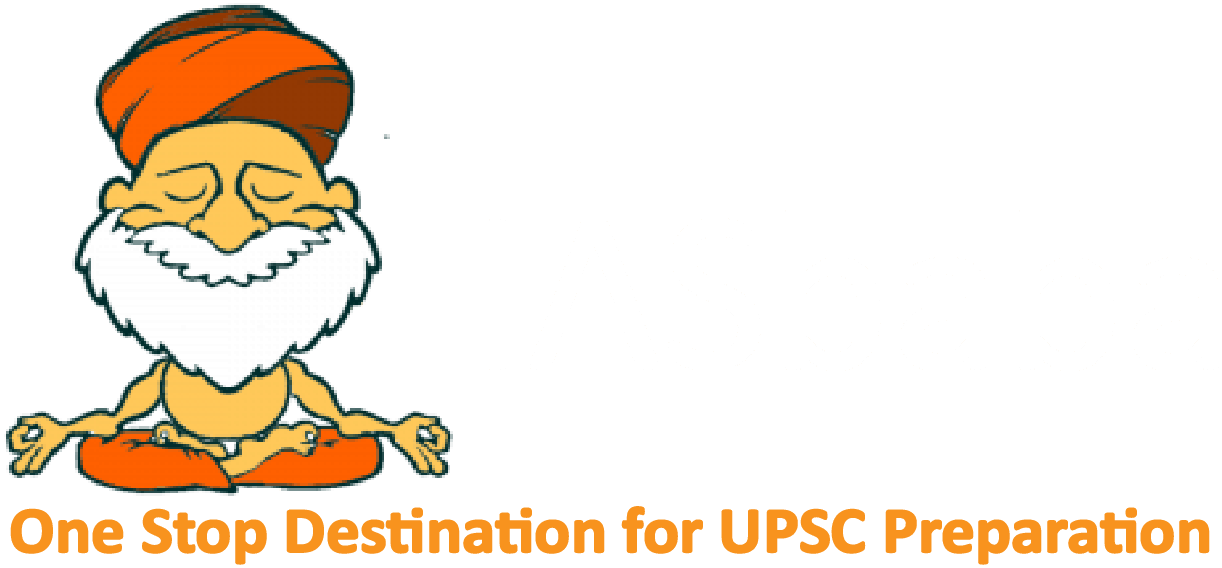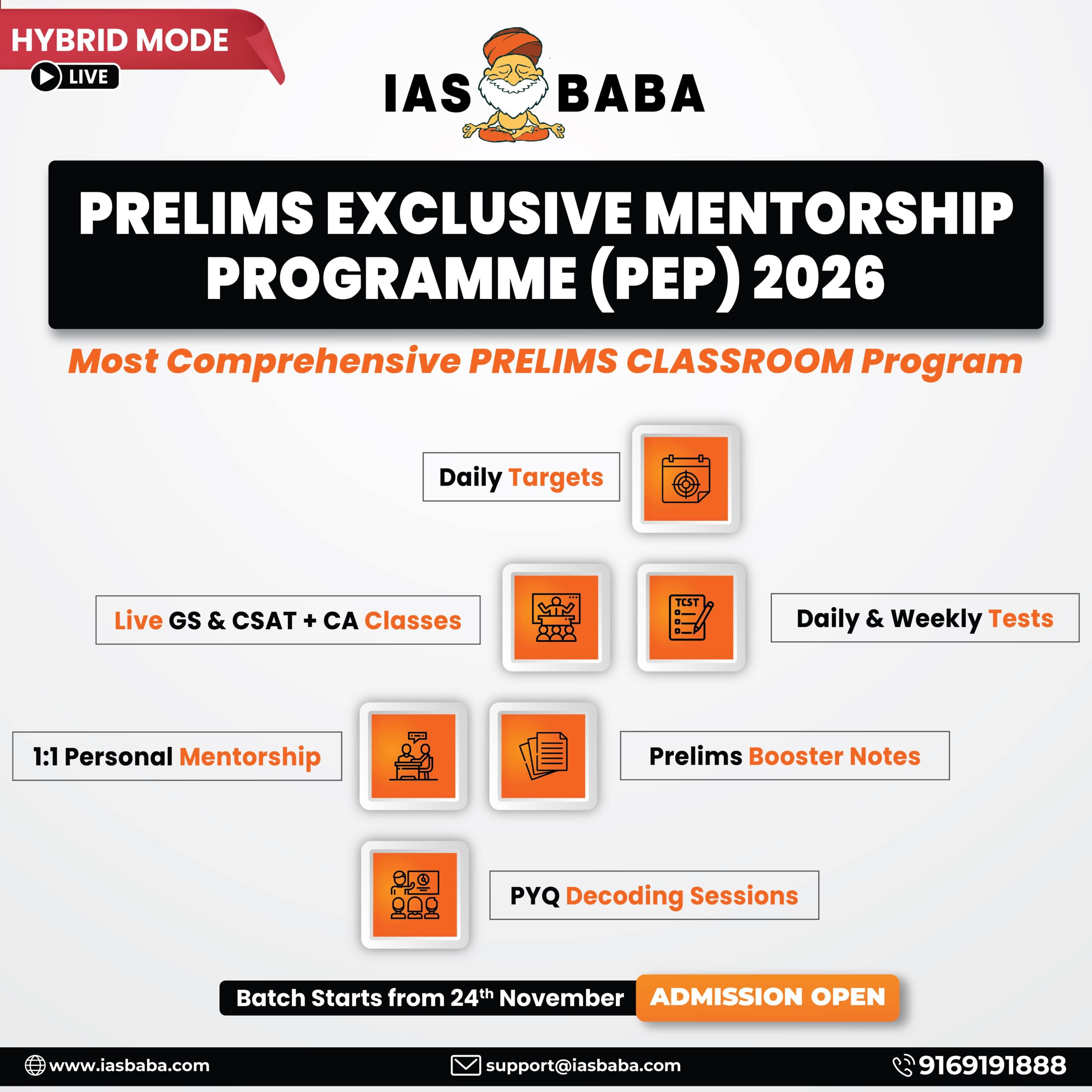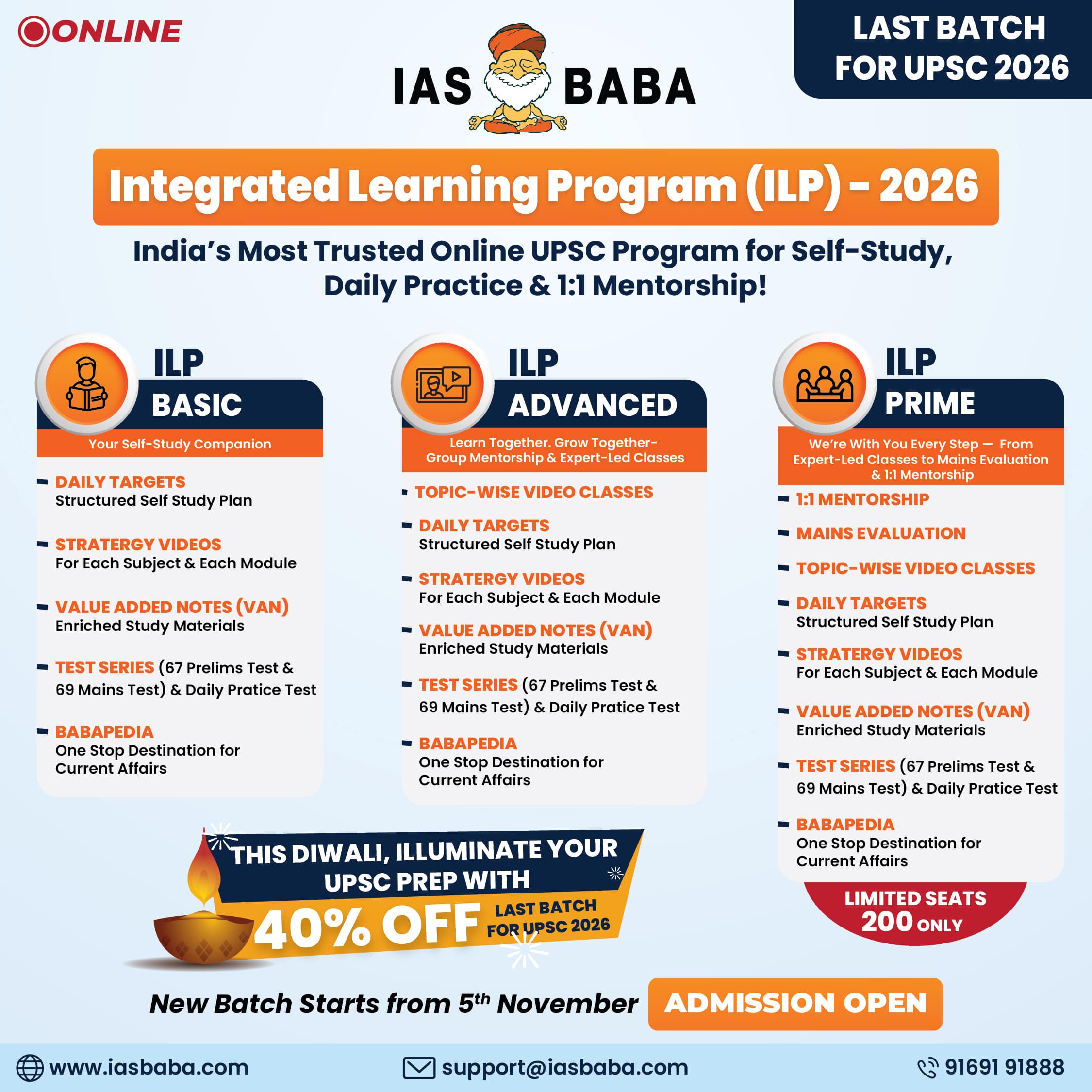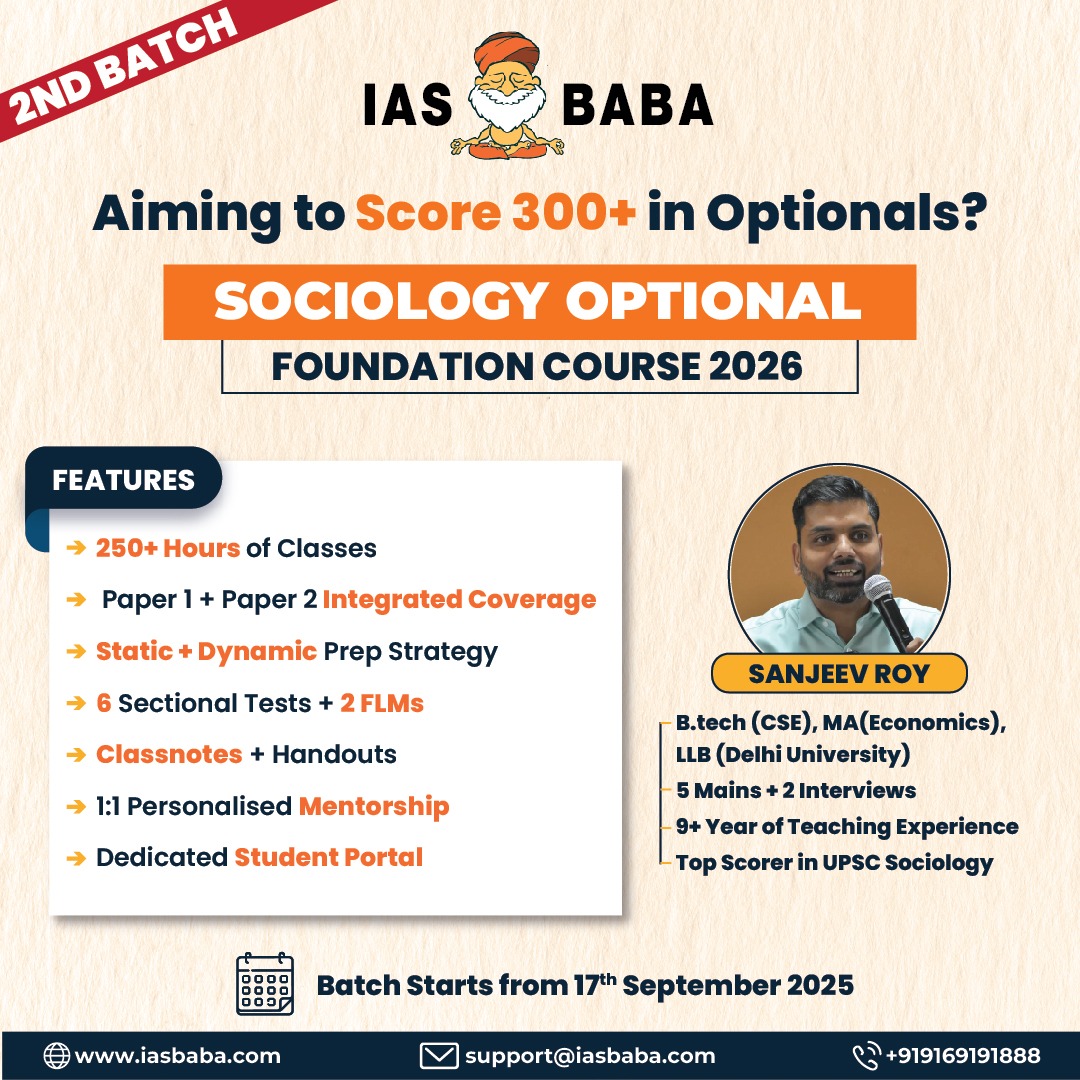IASbaba's Daily Current Affairs Analysis
rchives
(PRELIMS Focus)
Category: POLITY
Context: External Affairs Minister Dr. S. Jaishankar inaugurated the SAMHiTA Conference on South Asia’s Manuscript Traditions and Mathematical Contributions
Objectives
- Digital Archive: Digitize and unify manuscripts scattered across global collections for wider access.
- Mathematical Heritage: Highlight South Asia’s contributions to mathematics and related sciences.
- Global Collaboration: Partner with international institutions for preservation and knowledge exchange.
Key Highlights
- Dr. Jaishankar emphasized self-reliance in intellectual leadership and showcasing India’s civilizational and mathematical heritage.
- The initiative strengthens cultural diplomacy, enhances research infrastructure, and deepens India’s role in global knowledge networks.
Learning Corner:
South Asia’s Manuscript Traditions and Mathematical Contributions
Manuscript Traditions in South Asia
- Diversity of Scripts and Languages:
South Asia has one of the richest manuscript traditions in the world, spanning Sanskrit, Pali, Prakrit, Tamil, Persian, Arabic, and Tibetan among others. These manuscripts cover religion, philosophy, medicine, astronomy, mathematics, grammar, and arts. - Materials and Mediums:
Manuscripts were traditionally inscribed on palm leaves, birch bark, parchment, and handmade paper, often preserved in temples, monasteries, mathas, and royal libraries. - Centers of Manuscript Culture:
- Nalanda and Vikramshila Universities: Major repositories of Buddhist and scientific manuscripts.
- Kerala and Tamil Nadu: Palm-leaf manuscripts in Ayurveda, astronomy, and mathematics.
- Kashmir: Known for Shaiva and Buddhist manuscripts on birch bark.
- Persianate Traditions: Mughal patronage encouraged preservation of texts in astronomy, medicine, and mathematics.
- Transmission and Global Spread:
Manuscripts were carried along trade routes and through cultural exchanges to Central Asia, the Middle East, and Europe, influencing global knowledge systems.
Mathematical Contributions of South Asia
South Asia played a foundational role in global mathematical development:
- Decimal Place Value System & Zero:
The concept of zero as a number and the place value system emerged in India (e.g., Brahmagupta, 7th century CE). This became the foundation of modern arithmetic. - Algebra and Arithmetic:
- Aryabhata (5th century CE): Introduced place value notation, trigonometric functions (sine, cosine).
- Brahmagupta (7th century CE): Systematic rules for zero and negative numbers; quadratic equations.
- Bhaskara II (12th century CE): Solutions to indeterminate equations; contributions to calculus-like concepts.
- Geometry and Trigonometry:
- Sulbasutras (c. 800–500 BCE) contain rules for altar construction, approximations of √2, and Pythagorean triples.
- Indian trigonometric methods later influenced Islamic and European mathematics.
- Astronomical Mathematics:
Mathematics was closely tied to astronomy for calendar-making and planetary calculations. Works like Surya Siddhanta combined mathematics with cosmology. - Transmission to the World:
Indian numerals were transmitted via the Arabs (“Arabic numerals”) to Europe, revolutionizing commerce and science. Indian trigonometry and algebra shaped Islamic Golden Age mathematics.
Source: AIR
Category: POLITY
Context : India’s birth rate and Total Fertility Rate (TFR) have seen a notable decline in 2023–2025, marking the first dip in two years and pushing fertility further below the replacement level of 2.1.
Key Data
- Birth Rate: 18.4 per 1,000 in 2023 (down from 21.4 in 2013 and 36.9 in 1971).
- TFR: 1.9 in 2023–25, below replacement level.
- Rural vs Urban: Rural TFR at 2.1, urban rates lower.
- State Variation: Bihar and UP remain high; Kerala, Tamil Nadu, and Delhi report as low as 1.4–1.6.
Reasons for Decline
- Higher female literacy and workforce participation, leading to delayed marriages.
- Urbanization and rising costs encourage smaller families.
- Wider contraceptive use and family planning awareness.
- Youth migration for education and jobs.
Implications
- India’s population will likely peak at around 1.7 billion in the next 40 years before declining.
- Long-term effects include an aging population, shrinking workforce, and higher demand for elderly care.
- Policy focus will shift toward social security, healthcare for elderly, and labor market reforms.
Learning Corner:
Total Fertility Rate (TFR)
- Definition: TFR is the average number of children a woman is expected to have during her reproductive years (15–49 years), assuming current fertility patterns remain constant.
- Replacement Level Fertility: The TFR needed for a population to replace itself without migration is about 2.1 (slightly above 2 to account for child mortality).
- India’s Current Status: As of 2023–25, India’s TFR has declined to 1.9, below replacement level.
- Factors Influencing TFR:
- Female education and workforce participation
- Access to contraception and healthcare
- Socio-economic conditions and urbanization
- Cultural and regional variations
- Implications:
- A declining TFR leads to slower population growth, eventual population stabilization, and later population decline.
- It also causes population aging, reduced labor force, and increased demand for elderly care.
- However, it reflects progress in health, literacy, and women’s empowerment.
Source: THE HINDU
Category: INTERNATIONAL
Context: Singapore has officially backed India’s interest in joining joint patrols of the Malacca Straits, marking a new phase in bilateral maritime security cooperation and regional collaboration.
Key Details
- In September 2025, Prime Ministers Narendra Modi and Lawrence Wong discussed India’s formal role in the Malacca Straits Patrol (MSP), currently involving Indonesia, Malaysia, Singapore, and Thailand.
- Singapore views India’s participation as strengthening regional security, technology pooling, and balancing major power influence in the Indo-Pacific.
Strategic Importance
- The Malacca Strait is a vital chokepoint: nearly 40–50% of global trade and 70% of Asia’s oil imports pass through it.
- For India, about 60% of sea-based trade and almost all LNG imports transit this route.
- India’s Andaman & Nicobar Islands, just 600 km away, provide operational leverage for the Indian Navy.
Impact on Regional Security
- India’s entry will boost anti-piracy, anti-trafficking, and intelligence operations, drawing on its naval experience in the Gulf of Aden.
- It strengthens India’s Act East policy, deepens ASEAN-led security structures, and contributes to Indo-Pacific balance.
Technological Cooperation
- The partnership will advance collaboration in AI, quantum computing, unmanned vessels, and surveillance technologies.
- Joint ventures may include autonomous patrol craft and quantum-secure communications for maritime safety.
Learning Corner:
Malacca Strait
- Geography:
The Malacca Strait is a narrow stretch of water between the Malay Peninsula (Malaysia & Singapore) and the Indonesian island of Sumatra. It connects the Andaman Sea (Indian Ocean) with the South China Sea (Pacific Ocean). Its narrowest point, the Phillip Channel near Singapore, is only about 2.7 km wide, making it one of the world’s most significant maritime chokepoints. - Strategic Importance:
- Handles about 40–50% of global trade and nearly 70% of Asia’s oil imports.
- Vital for energy flows from the Middle East and Africa to East Asia.
- For India, around 60% of its maritime trade and almost all LNG imports pass through this corridor.
- Security Concerns:
- Vulnerable to piracy, trafficking, smuggling, and potential blockades.
- The presence of multiple stakeholders (Indonesia, Malaysia, Singapore, and Thailand) makes cooperative security essential.
- India’s Significance:
- India’s Andaman & Nicobar Islands lie just 600 km away, giving India strategic proximity.
- Participation in the Malacca Straits Patrol (MSP) enhances India’s Act East Policy and Indo-Pacific strategy.
- Global Relevance:
Securing the Malacca Strait is critical for global energy security, freedom of navigation, and Indo-Pacific stability.
Source: THE HINDU
Category: POLITY
Context : Ensures effective implementation of PMAY-U 2.0, promotes community participation, and facilitates convergence of social welfare schemes toward “Housing for All.”.
- Launch: September 4, 2025, by Minister Manohar Lal in New Delhi.
- Duration & Reach: September 4 to October 31, 2025, covering over 5,000 Urban Local Bodies (ULBs).
- Objectives:
- Last-mile outreach to PMAY-U beneficiaries.
- Accelerate application verification and completion of sanctioned houses.
- Raise awareness about linked schemes like CRGFTLIH and PM Surya Ghar.
- Prioritize housing needs of vulnerable groups under Special Focus Group (SFG).
- Community Mobilization: Door-to-door campaigns, awareness drives, cultural programs, and Jan Bhagidari initiatives.
Learning Corner:
Pradhan Mantri Awas Yojana – Urban (PMAY-U)
- Launch: 25 June 2015, by the Ministry of Housing and Urban Affairs.
- Objective: Provide affordable housing for all urban poor by 2030, focusing on economically weaker sections (EWS), low-income groups (LIG), and slum dwellers.
- Key Components:
- In-situ Slum Redevelopment (ISSR) – Redevelop slums using private participation.
- Affordable Housing through Credit Linked Subsidy (CLSS) – Interest subsidy on home loans.
- Beneficiary-Led Construction (BLC) – Financial assistance for building or improving houses.
- Public-Private Partnership / Affordable Housing in Partnership (AHP) – Promote affordable housing projects via private developers.
- Urban Focus: Implemented across Urban Local Bodies (ULBs), covering all cities and towns.
- Special Initiatives: PMAY-U 2.0, Angikaar campaigns, PMAY-U Awas Diwas, and PM Awas Mela for last-mile outreach and scheme acceleration.
- Significance: Advances the “Housing for All” mission, improves urban living conditions, promotes social inclusion, and facilitates convergence with other welfare schemes.
Source: PIB
Category: HISTORY
Context: Contribution to education on the eve of teachers day.
- Contribution: India’s first female teacher and pioneer of women’s education.
- Key Achievements:
- Opened the first girls’ school in Pune in 1848 with her husband Jyotirao Phule.
- Developed curricula tailored for girls, emphasizing literacy, hygiene, and social awareness.
- Authored poems and texts to inspire girls and women to pursue education.
- Challenges: Faced social hostility, including threats and ostracism, but persisted to empower marginalized communities.
- Legacy: Laid the foundation for women’s education among lower-caste and marginalized communities.
Learning Corner:
Jyotirao Phule (1827–1890)
- Contribution: Social reformer and educationist; husband of Savitribai Phule.
- Key Achievements:
- Advocated for education for girls and lower-caste communities.
- Supported Savitribai Phule in opening schools and literacy campaigns.
- Worked to eradicate untouchability and caste-based discrimination in education.
- Legacy: Promoted inclusivity in education and laid early groundwork for social justice.
Raja Ram Mohan Roy (1772–1833)
- Contribution: Pioneer of modern India’s social and educational reforms.
- Key Achievements:
- Founded Hindu College (1817) in Kolkata to modernize education.
- Championed the cause of women’s rights, including opposition to Sati.
- Promoted learning in English, science, and rational thinking, opening avenues for women indirectly.
- Legacy: Father of the Indian Renaissance; set the stage for women’s empowerment through education reform.
Ishwar Chandra Vidyasagar (1820–1891)
- Contribution: Educationist and social reformer focused on widows and women’s literacy.
- Key Achievements:
- Advocated for widow remarriage through the Widow Remarriage Act, 1856.
- Opened schools for girls, especially in Bengal, providing literacy and moral education.
- Developed textbooks in Bengali, making education accessible to girls.
- Legacy: Combined legal reforms with educational initiatives to uplift women.
Pandita Ramabai (1858–1922)
- Contribution: Pioneer of women’s education and social reform.
- Key Achievements:
- Founded the Arya Mahila Samaj and Sharada Sadan for widows’ education.
- Advocated for women’s literacy, vocational training, and emancipation.
- Authored works in Marathi, Sanskrit, and English to highlight women’s issues.
- Legacy: Empowered widows and underprivileged women through education and skill development.
Annie Besant (1847–1933)
- Contribution: British-born social reformer and educationist in India.
- Key Achievements:
- Promoted women’s education and adult literacy.
- Founded Central Hindu College (1898), which later became Banaras Hindu University.
- Advocated for women’s rights and self-reliance through education.
- Legacy: Integrated Western and Indian educational ideas for female empowerment.
Mahadevi Verma (1907–1987)
- Contribution: Poet, educationist, and champion of women’s education in Hindi literature.
- Key Achievements:
- Served as Vice-Chancellor of BHU and promoted women’s participation in higher education.
- Advocated cultural and literary education for girls and women.
- Legacy: Advanced higher education and cultural empowerment for women.
Source: PIB
(MAINS Focus)
Introduction (Context)
The Himalayas, the world’s youngest and most fragile mountain system, are increasingly witnessing frequent disasters such as floods, landslides, and glacial lake outburst floods (GLOFs). Experts caution that labelling every heavy-rain event as a “cloudburst” oversimplifies the crisis.
In reality, these disasters are often the outcome of a dual force climate change and unregulated development.
Recent disasters
- In August–September 2025, North India witnessed severe floods and landslides due to overflowing Sutlej, Beas, and Ravi rivers.
- 34 People died after intense rainfall in Kashmir and Pakistan-occupied areas.
- The village of Dharali (Uttarakhand) was washed away by a deluge-triggered landslide.
They were labelled as “unprecedented natural events”, ignoring the role of reckless development.
How rampant development has triggered disasters?
The Himalayas, being the world’s youngest mountain range, are inherently unstable and highly sensitive to external interventions.
While they are naturally prone to landslides, floods, and seismic activity, unregulated development has amplified disaster potential manifold.
Some of the reasons are:
Copying of Urban Development Models
- Development plans in Himachal Pradesh and Uttarakhand are often modeled on metropolitan cities like Delhi and Mumbai, ignoring Himalayan fragility.
- Experts emphasize that every project must undergo lifecycle analysis and carrying capacity assessment before implementation.
Weak Environmental Safeguards
- Most major projects are cleared without independent disaster and social impact assessments or proper public consultation.
- This lack of oversight means roads, tunnels, and hydropower plants often destabilize slopes and block natural drainage systems.
Proliferation of Hydropower Projects
- According to the Directorate of Energy of Himachal Pradesh, there are 1,144 hydropower plants in the state, of which 721 are at various stages of clearance and investigation, 180 have been commissioned, and 53 are under construction. The Centre has also sanctioned funds to build new bridges and widen roads.
- Similarly, in Uttarakhand, there are 40 operational hydroelectric plants while 87 more are at various stages of planning and construction, all to boost the State’s power generation capacity.
- Such projects involve blasting, tunneling, and river diversion, further weakening fragile slopes and river valleys.
Infrastructure Boom Without Risk Sensitivity
- Highway widening and tunnel construction, for example e.g., 14 tunnels on Chandigarh–Manali route. Heavy equipment use destabilizes slopes, making them prone to landslides during heavy rainfall.
Tourism and Encroachment Pressure
- Rising tourist inflow has accelerated demand for hotels, homestays, and commercial establishments.
- This leads to deforestation, slope cutting, and construction on unsafe land, which increases downstream flood and landslide risks.
Climate Change as a Risk Multiplier
- The Himalaya is warming faster than the global average, causing reduced snowfall and accelerated glacier melt. This leads to the formation of unstable glacial lakes, increasing the risk of Glacial Lake Outburst Floods (GLOFs).
- ICIMOD (2018) reported over 25,000 glacial lakes across five major river basins, placing downstream communities at high risk.
- Climate change thus compounds existing vulnerabilities, turning natural hazards into frequent and severe disasters.
Legal and Judicial Interventions
Legal insights
- Supreme Court (July 18, 2025): Warned that if unchecked, “the day is not far when Himachal Pradesh may vanish from the map.” Stressed ecological sustainability cannot be sacrificed for revenue.
- Chief Justice B.R. Gavai (Sept 4, 2025): Described floating logs in floodwaters as a “very serious issue.” Said development must not come at the cost of environment and human lives.
- Petition Against NHAI (Sept 2025): Allegation: 14 tunnels between Chandigarh–Manali turned into “death traps” during rains. Court issued notice to NHAI for lack of disaster sensitivity in project design.
- These interventions reflect the judiciary’s growing concern that development is being pursued without considering Himalayan carrying capacity.
Expert Insights
- Arun B. Shreshta (ICIMOD): Disasters are not purely natural; they stem from climate change + reckless development. Advocates carrying capacity assessments and lifecycle-based planning.
- Himanshu Thakkar (SANDRP): Prioritize independent disaster and social impact assessments with public participation before approving projects.
- Navneet Yadav (Caritas India): Warns against copying urban-centric development models (Delhi/Mumbai) for Himalayan states. Calls for context-sensitive planning.
Way Forward
- Conduct carrying capacity studies before new projects.
- Enforce independent EIAs and disaster impact assessments.
- Strengthen local forest cover, promote slope stabilization through vegetation.
- Restore river floodplains and wetlands as natural buffers.
- Build climate literacy among locals.
- Empower panchayats and local governance institutions to lead disaster preparedness.
- Promote eco-tourism.
- Restrict construction in eco-sensitive zones.
- Schools, hospitals, and relief shelters must be located in safe zones.
- Design tunnels, highways, and bridges to account for Himalayan seismicity and rainfall intensity.
Conclusion
The Himalayan crisis is not merely about climate change, but about unchecked human intervention in one of the world’s most fragile ecosystems.
Disasters are amplified by hydropower projects, highways, deforestation, and unregulated tourism.
Unless India urgently rethinks its development model with climate-sensitive, community-driven, and nature-based solutions, the Himalayas could face irreversible damage with devastating consequences for millions downstream.
Mains Practice Question
Q The Himalayan disasters are less a result of climate change alone and more a consequence of reckless development practices.” Critically examine. (250 words, 15 marks)
Source: Rampant development, not climate, pushing Himalaya to the edge – The Hindu
Introduction (Context)
The 56th GST Council Meeting (3rd September 2025) introduced GST 2.0, marking a historic step towards a simpler, fairer, and growth-oriented taxation system aligned with the vision of Viksit Bharat 2047.
What is Goods and Service Tax?
- India introduced the Goods and Services Tax (GST) on July 1, 2017, marking a historic change in the country’s tax system.
- Before GST, people and businesses had to deal with different indirect taxes such as VAT, excise duty, and service tax. This often created confusion, double taxation, and a heavy burden on businesses.
- GST was brought in to make taxation simpler, transparent, and uniform across the country.
- It applies to both goods and services, making it easier for the government to collect revenue and for businesses to comply with tax rules.
GST in India is divided into four categories to ensure smooth collection by both the central and state governments:
- CGST (Central GST): Collected by the central government on transactions within a state.
- SGST (State GST): Collected by the state government on transactions within a state.
- IGST (Integrated GST): Collected by the central government on interstate transactions (when goods or services move from one state to another).
- UTGST (Union Territory GST): Collected on transactions within Union Territories.
What is GST 2.0?
With GST rationalisation, the government has collapsed multiple slabs into four: 0%, 5%, 18%, and a new 40% for luxury and sin goods. Gone are the 12% and 28% brackets that often-left consumers scratching their heads and businesses juggling input credits.
The New GST Slabs 2025
| GST Slab | Category | Examples of Goods/Services |
|---|---|---|
| 0% | Essentials & daily needs | Paneer, Indian breads (roti/chapati), UHT milk, erasers, essential medicines |
| 5% | Merit/basic goods | Soaps, toothpaste, packaged food, hair oil, agricultural equipment |
| 18% | Standard goods & services | TVs, air conditioners, washing machines, small cars, salon services |
| 40% | Luxury & sin goods | Tobacco, pan masala, sugary beverages, high-end cars, luxury goods |
This tiered structure is designed to protect the common man while discouraging harmful consumption habits.
Key features of the reform
- Relief for Households & Consumers
GST 2.0 directly impacts daily consumption patterns by making essentials and common-use items more affordable.
- Exempted Items: Ultra-High Temperature (UHT) milk, paneer, chapati, and paratha are fully exempt, easing household budgets.
- 5% Bracket: Everyday goods such as soap, shampoo, toothpaste, bicycles, and kitchenware now fall under the 5% rate, reducing out-of-pocket expenses for middle- and lower-income households.
- Reduced Rates: Packaged foods, noodles, chocolates, and beverages have seen cuts, encouraging higher consumption and benefiting FMCG and retail sectors.
- Insurance Exemption: Exempting all life and health insurance policies makes coverage more affordable. This is particularly significant for senior citizens and low-income families, enhancing financial protection and social security.
- Healthcare Boost: Essential drugs, medical devices, and treatments for cancer, rare diseases, and chronic conditions have been exempted or shifted to lower rates, widening access to healthcare and easing financial burdens on households.
- Support for Farmers
- Reforms have been designed to reduce costs in the agricultural sector and improve rural productivity.
- 5% GST on Farm Equipment: Tractors, farm machinery, fertilizers, and inputs like sulphuric acid and ammonia now attract only 5% GST.
- This not only reduces cultivation costs but also corrects earlier inverted duty structures, ensuring farmers pay less for critical inputs while selling produce competitively.
- By lowering agricultural expenses, the reform improves farm profitability and strengthens the rural economy.
- Boost to Labour-Intensive Sectors
- The reform pays special attention to traditional and labour-intensive industries, which provide mass employment.
- Sectors such as handicrafts, marble, granite, and leather goods are now under reduced GST slabs.
- This rationalisation improves competitiveness in domestic and export markets, stimulates consumer demand, and safeguards millions of livelihoods dependent on these industries.
- Critical Sectoral Changes
Several strategic sectors with high multiplier effects have seen long-awaited corrections.
- Textiles: The reduction of GST on man-made fibre and yarn to 5% eliminates distortions in the textile value chain, boosting domestic value addition, exports, and job creation.
- Cement: Lowering GST from 28% to 18% will reduce construction costs, provide a push to affordable housing, and accelerate infrastructure development.
- Green Growth: Reductions on renewable energy devices and automotive components incentivise clean energy adoption and support India’s transition towards a sustainable and low-carbon economy.
Institutional reforms
- GSTAT (Goods and Services Tax Appellate Tribunal) will be operational by year-end, ensuring faster dispute resolution, consistency in rulings, and greater taxpayer trust.
- Provisional Refunds for Inverted Duty Structures: When input tax is higher than the tax on finished goods, businesses pay extra tax (inverted duty). Now, the government will refund this excess quickly, improving cash flow and reducing financial stress for small manufacturers.
- Risk-Based Compliance Checks: The government uses data and technology to check only “high-risk” taxpayers (like fake invoices), while honest taxpayers face minimal scrutiny. This reduces harassment, saves time, and helps focus on real tax evasion.
- Harmonisation of Valuation Rules: GST valuation means deciding the value on which tax is charged. By standardising rules across states and sectors, disputes are reduced, the system becomes uniform, and transparency for businesses increases.
Impact on Businesses
The reform reshapes the business environment with a mix of ease and adjustments:
- Simplified Filing: Fewer tax slabs reduce confusion and classification disputes.
- Reduced Compliance Burden: SMEs and retailers gain from easier invoicing and accounting.
- Pricing Challenges: Industries dealing in luxury or sin goods need to recalibrate their pricing strategies.
- Sectoral Gains: FMCG and insurance sectors are expected to see demand growth due to affordability and wider coverage.
Wider Economic Impact
Economists view GST 2.0 as a growth-oriented reform:
- GDP Growth: Expected to raise GDP by around 100–120 basis points in the coming quarters.
- Revenue Implications: A short-term dip in government revenue (~₹48,000 crore) may occur, but will be offset by higher consumption and compliance.
- Boost to Sentiment: Reduced household expenditure strengthens consumer confidence, especially benefiting retail and FMCG demand.
Conclusion
GST 2.0 is not just a tax adjustment but a transformational reform. By simplifying slabs, correcting distortions, lowering rates on essentials, and strengthening institutions, it delivers relief across income groups, supports farmers, boosts industry competitiveness, and aligns with the vision of Viksit Bharat 2047. It stands as a defining milestone in India’s tax history, embodying a genuine people’s reform.
Mains Practice Question
Q GST 2.0 marks a shift from a complex, compliance-heavy tax system to a simplified, people-centric reform.” Critically examine the economic and social implications of the new two-rate GST structure in the context of India’s growth trajectory towards Viksit Bharat 2047. (250 words, 15 marks)
Source: GST 2.0 is a landmark in India’s tax journey – The Hindu














